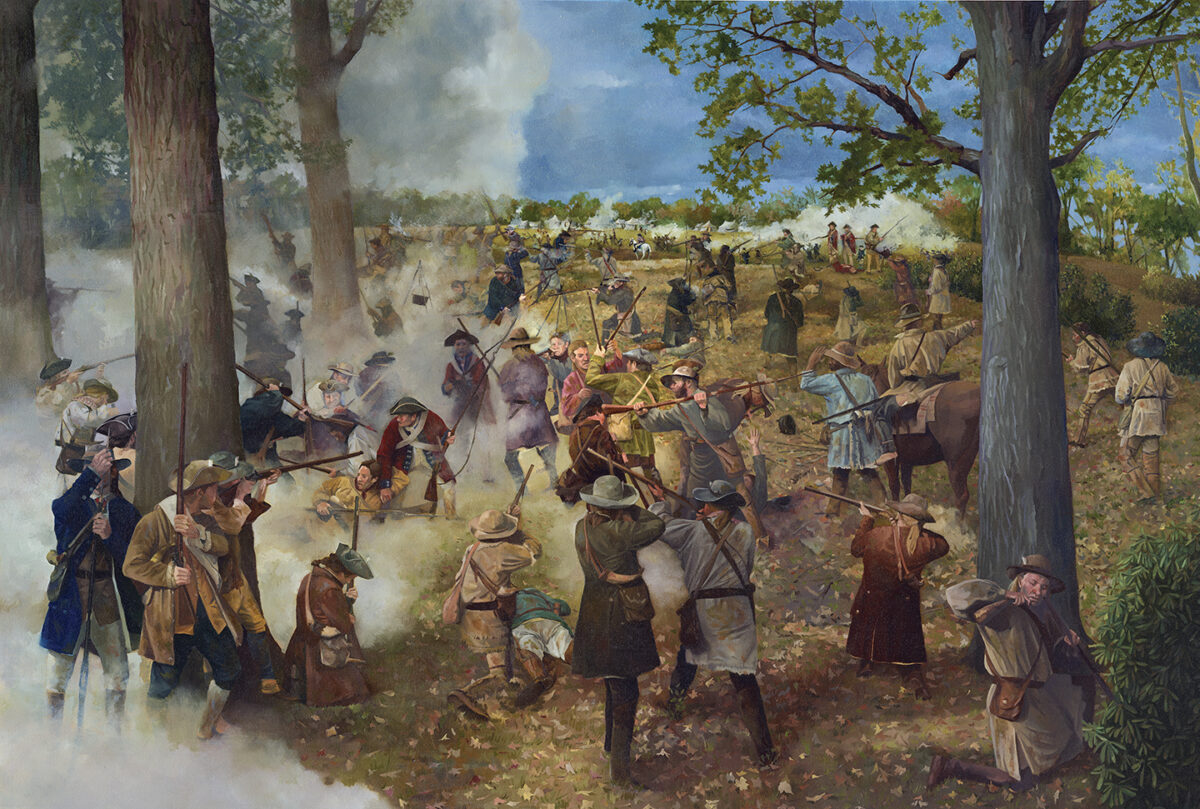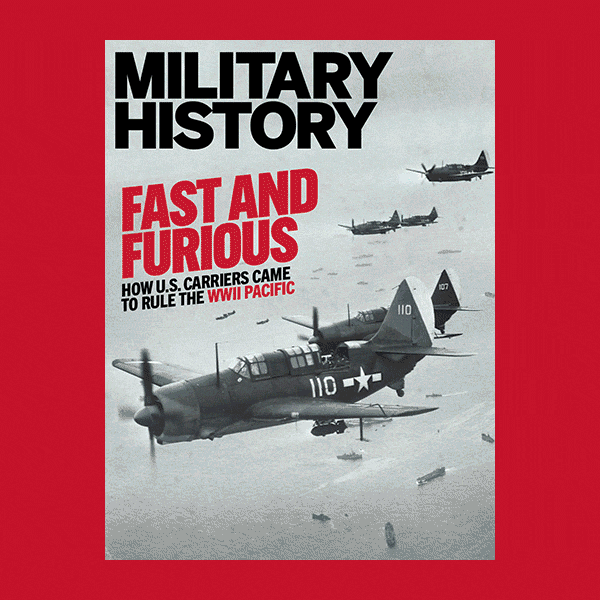It was 1760, in the midst of the Seven Years’ War, and 16-year-old Cornet Patrick Ferguson was having the time of his life. He and another young officer were on horseback a few miles out in front of the British army when they ran afoul of a party of French-allied German hussars. Deciding it prudent to retire, they turned and spurred their mounts. As his horse jumped a ditch, Ferguson dropped one of his pistols. The naive lad, thinking it improper for an officer to return to camp without all his weapons, recrossed the ditch in the face of the pursuing enemy and dismounted to recover his pistol. The hussars, perhaps surmising a British dragoon wouldn’t be so foolhardy unless he had spotted friendly reinforcements, halted in their tracks. They looked on warily as Ferguson remounted, jumped his horse back over the ditch and joined his companion. The fortunate young men regained the British camp undisturbed.
Though Ferguson seemed to lead a charmed life in uniform, such reckless behavior in action would one day catch up to him.
Patrick Ferguson was born in on June 4, 1744, in Pitfour, Aberdeenshire, Scotland, the son of a titled and well-connected lawyer. The Fergusons had a long tradition of military service, and from childhood Patrick resolved to pursue a career in the army. Accordingly, when the boy reached the tender age of 12, his father sent him to a military academy in London. At that time in European history a gentleman desiring to be an officer in the military could purchase his commission from a regimental commander. From there he might earn merit-based promotions, but he could also purchase ranks in turn. Ferguson’s father purchased his son’s first commission, as a cornet in the 2nd (Royal North British) Dragoons (aka “Royal Scots Greys”), when Patrick was just 14. Dragoons were mounted infantry, who rode horses into battle and then fought on foot. In 1760 Ferguson’s regiment deployed to continental Europe, where he got his first taste of combat in Flanders and Germany and lived to tell of his close encounter with hussars.
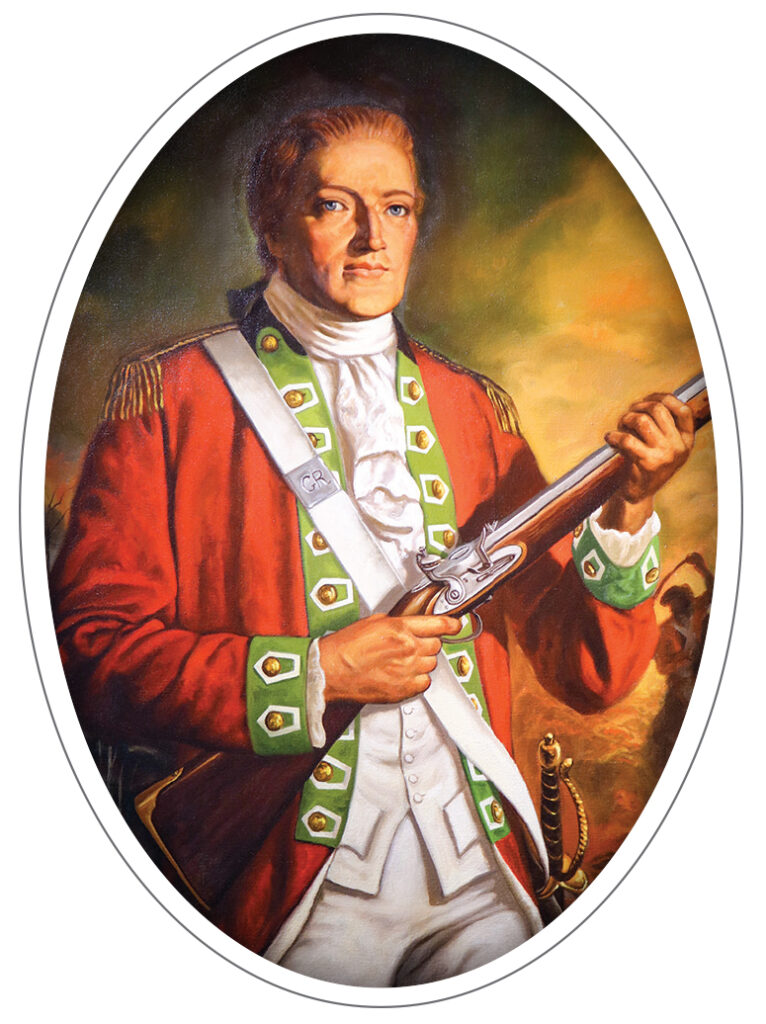
In 1768, though Ferguson had cut his teeth with eight years of service, his father again purchased a commission for him, as a company commander in the 70th (Glasgow Lowland) Regiment of Foot, then serving in the West Indies. Late that year Captain Ferguson sailed to join his company in Tobago. Attuned to the well-being of his men, he had them take advantage of the tropical climate and grow vegetables as a supplement to their usual provisions of salted beef. While there, however, Ferguson himself contracted what was probably extrapulmonary tuberculosis. Related tubercular arthritis racked his knees with pain for the remainder of his life. After a brief stopover in the North American colonies, Ferguson returned to Britain in 1774.
By then it was clear that unrest with oppressive taxation and domineering British governance was approaching a breaking point in the American colonies. When British officers spoke among themselves, one oft-discussed point of concern was the colonials’ possession of precision hunting rifles—not in terms of numbers of weapons, which was not great, but because in the hands of skilled marksmen they were deadly at long range. In the event of war, of course, British officers would be the favored targets of such sharpshooters.
The standard long arm in the British military of the era was the “Brown Bess” muzzle-loading smoothbore flintlock musket, though it was notoriously inaccurate. An 1841 Royal Engineers test of the Brown Bess (in service from 1722 till 1838) recorded hits on man-sized targets at 150 yards only 75 percent of the time. Beyond that range the musket failed to hit even larger targets. Its point-blank range—the distance at which a round remains on a horizontal line of flight—was just 75 yards.

The rifle, while more accurate, also had its drawbacks. Foremost was its slow reload time. While an adept soldier with a musket could fire some three to five rounds a minute, with a rifle he might manage only one or two shots a minute. Most rifles also had no means of attaching a bayonet, at a time when bayonet charges often proved decisive.
In set-piece battles of the day opposing armies lined up opposite one another, approached within effective range, fired by volley, then reloaded and repeated. Given the unlikelihood of scoring a hit, the line infantry drilled to reload as fast as possible and put more lead in the air, improving their odds. This madness continued until one side or the other appeared vulnerable, at which point the side sensing an advantage would launch a bayonet charge to finish the fight. Thus muskets, given their rate of fire and the ability to mount a bayonet, remained the long arm of choice for the rank and file. Realizing the limitations of his weapon, each soldier generally aimed at an enemy formation and hoped to hit someone, anyone. But soldiers tasked with reconnaissance and surveillance, such as the German Jägers, preferred rifles. Tasked with observing and reporting on the enemy from a distance, they required a weapon with long-range accuracy. God help them were they in bayonet range.
On his return to Britain in 1774 Captain Ferguson resolved to develop a faster-loading service rifle than those in use. If he could do so, it would eliminate the hidebound British military’s primary reasons for retaining the wildly inaccurate smoothbore. European gunmakers started experimenting with rifling as early as 1498, originally applying grooves to the insides of barrels in order to collect fouling. The black powder propellant of the era left a tremendous amount of residue, about 80 percent of the powder in each charge remaining behind to foul the weapon. Stabilizing the bullet was a happy and unexpected side effect of adding the rifling. If Ferguson could conceive of a faster action and add a bayonet lug to his new rifle, all the better. After searching for technological advancements and examining a range of existing weapons, he settled on a breechloader.
Breech-loading rifles had been in regular use for decades prior to Ferguson’s interest. What he did do was use his force of will, coupled with his family connections as minor nobility, to oblige senior military officers to listen to his proposals. Using family money, the captain contracted with the head armorer at the Tower of London to design a breechloader according to his specifications. After a period of trial and error, the Ferguson rifle was born. It centered on an innovative screw breech. With a working model in hand the inventor again wielded his political connections to arrange a demonstration for Lord George Townshend, master general of the Ordnance, and senior British officers. After winning them over, Ferguson was invited to Windsor Castle to demonstrate the rifle before King George III himself.
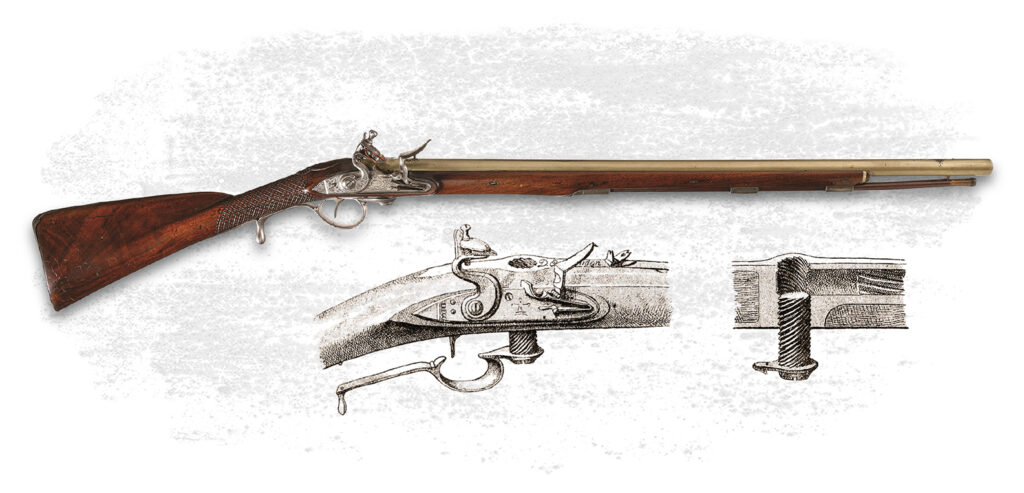
During his tests Ferguson was able to fire between four and six shots a minute and hit the bull’s-eye consistently at 200 yards. He was also able to reload his breechloader from the prone position, an impossibility for musketeers, as they had to at least kneel to pour powder down the barrel and manipulate a ramrod to force a ball down the muzzle. Ferguson simply rotated the trigger guard to open the screw breech and poured in powder, all from the ground. In a further demonstration of his rifle’s merits, he doused the loaded breech with water. In the black powder era a soggy charge wouldn’t fire—hence the expression, “Keep your powder dry.” To remove a wet charge from a musket, its owner had to thread a steel screw on the end of his ramrod, drive it down the barrel until it hit the ball, twist the screw into the soft lead, pull out the ball, dump the wet powder and then reload. The tedious process required the assistance of another person, to either hold the musket or manipulate the ramrod. In the midst of combat such fumbling might well prove fatal. Ferguson was able to screw open his breech, tap out the damp charge, add dry powder and screw it closed, again while remaining prone.
Duly impressed, his superiors placed an order for 100 Ferguson rifles and assigned the captain command of a light infantry unit, to be armed with his breechloader and employed in the American colonies, by then in open rebellion against the Crown. The men in his command would be volunteers, drawn from the assorted regiments already serving in the colonies.
While Ferguson prepared to ship overseas, a complication arose. As the Industrial Revolution remained in its earliest stages, Britain lacked factories able to mass produce firearms. Each weapon had to be produced individually by a gunsmith. Furthermore, fabricating the lands and grooves inside a rifle barrel was labor intensive, taking far longer to complete than the smoothbore barrel of a musket. Even with multiple gunsmiths working to create Ferguson’s rifles, there were nowhere enough to complete the 100 ordered weapons before he embarked.
In the end only 67 of Ferguson’s rifles were ready by the time he left in March 1777 to join Maj. Gen. Sir William Howe’s army in North America. On arrival the captain traveled among the various regiments to demonstrate the rifle and recruit 100 soldiers for his command. Finally, he began training his enlistees how to operate as light infantrymen armed with rifles. Due to the shortage of his namesake gun, Ferguson had to arm the remainder of his troops with traditional muzzle-loading rifles already in use; the remaining 33 Ferguson guns shipped from Britain that June. When he deemed his men ready, Ferguson was assigned to Hessian Lt. Gen. Wilhelm von Knyphausen’s command, then in New York.
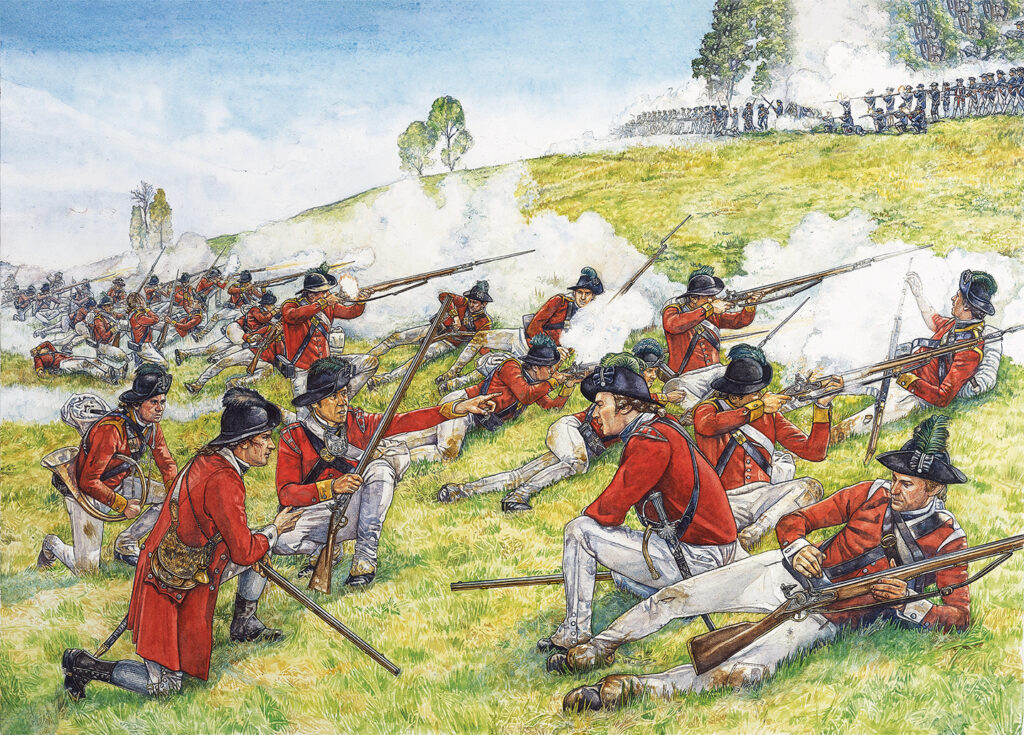
The Ferguson rifle was about to get its trial by fire.
On Sept. 11, 1777, during the British campaign to capture Philadelphia—then capital of and largest city in the nascent United States—Howe’s British army met General George Washington’s Continental Army near Chadds Ford, Penn. The subsequent Battle of Brandywine was the second longest single-day battle of the war, with continuous fighting lasting 11 brutal hours. More troops fought at Brandywine than at any other battle in the North American theater of the war. Marching in the vanguard, Ferguson’s rifle corps was tasked with screening the main British army, so American forces couldn’t get a clear picture of Howe’s plans. The resulting British victory enabled Howe to capture Philadelphia two weeks later, prompting the Continental Congress to flee, first to Lancaster and then York, Pa.
Although his rifle corps performed its tasks admirably at Brandywine, Ferguson had been struck by a musket ball that shattered his right elbow, a wound that sidelined him from active duty for some months as he recovered. All things considered, he was fortunate. In the days before orthopedic trauma care, a wound such as he’d received would often lead to amputation, or at least medical retirement from the military. Ferguson refused to have his arm amputated, and he quite literally wouldn’t surrender his officer’s sword. Since the shattered elbow cost him full use of his arm, the right-handed major taught himself to wield his saber left-handed. It was such single-minded dedication and dogged determination that earned Ferguson the nickname “Bulldog.”
Brandywine was uniquely linked to Ferguson for another incident—one that proved among the most remarkable and enduring stories (or perhaps legends) of the war.
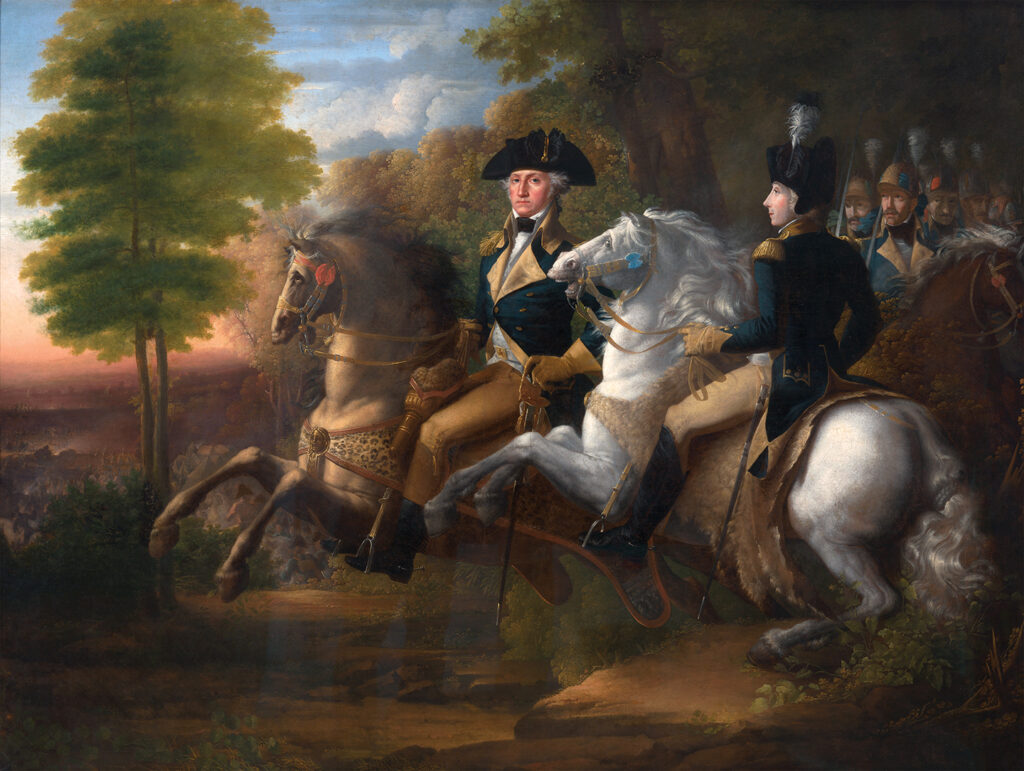
While he and his men were engaged in screening duties far in advance of British lines, Ferguson observed two American officers conducting a similar reconnaissance of the British. One was mounted on a bay horse and wore an especially large bicorne hat. The officers appeared unconcerned, as they remained well out of musket range. They were not out of rifle range, however, and Ferguson ordered three of his men to prepare to fire. Harboring reservations, Ferguson thought it advantageous to try and capture the American officers. Thus, he stepped into the open and called for them to ride toward him and surrender, or he would have his men shoot. At that, the Continentals simply turned their horses to ride away. Being out of musket range, they didn’t even feel it necessary to spur their mounts beyond a walk. Before Ferguson could give the order to fire, he again had second thoughts. The American officers posed no immediate threat to the British, and it certainly wouldn’t be sporting to have them shot in the back, so he had his riflemen stand down.
Later that day, when Ferguson was at the field hospital getting treated for his elbow wound, he struck up a conversation with a British surgeon who had also treated several wounded American officers. From details the surgeon gleaned from the wounded captives it seemed the two officers Ferguson had spared were none other than General Washington and an aide-de-camp. Lieutenant John P. de Lancey, Ferguson’s second-in-command, who had seen Washington before the war, later suggested the enemy officer in the cocked hat had been Brig. Gen. Casimir Pulaski, the Polish volunteer credited as the “father of American cavalry.” Whether it was Pulaski or Washington, and Ferguson had missed his chance to end the war on the spot, he later wrote that he didn’t regret his decision.
While the Bulldog was recovering from his injury and mourning the death of his father back in Britain, the British were formulating a new strategy for their campaign in North America. The first few years of the war had primarily been fought in New England and mid-Atlantic colonies, and though the British had won most of the battles, they had yet to deliver a knockout blow. Meanwhile, the populace back home had grown increasingly weary of sending off their sons and spending their tax money to fight a seemingly endless war. Thus, in late 1778 Lt. Gen. Sir Henry Clinton launched a campaign in the South, hoping to spark an uprising of Loyalists, colonists born in North America but remaining loyal to the Crown. Were that successful, Clinton hoped to force the Americans to capitulate. The campaign began auspiciously enough with the capture of Savannah, Ga., that December 29, which the British successfully defended in October 1779. The day after Christmas Clinton and his second-in-command, Lt. Gen. Charles Cornwallis, left Knyphausen to garrison New York City and sailed for Savannah with a substantial army.
Having recuperated enough by then to return to active duty, Ferguson was commissioned a major in the 70th Regiment of Foot and embarked with the expedition. In the absence of its dynamic founder, however, Ferguson’s rifle corps had disbanded, its men returning to their original regiments, their rifles either put in storage or parceled out to other units. The major returned to service without a command to lead.
Regardless, his superiors recognized Ferguson’s leadership ability, and Cornwallis gave him command of a battalion of provincial Loyalist militia. In that capacity Major Ferguson would participate in the largest all-American battle of the war.
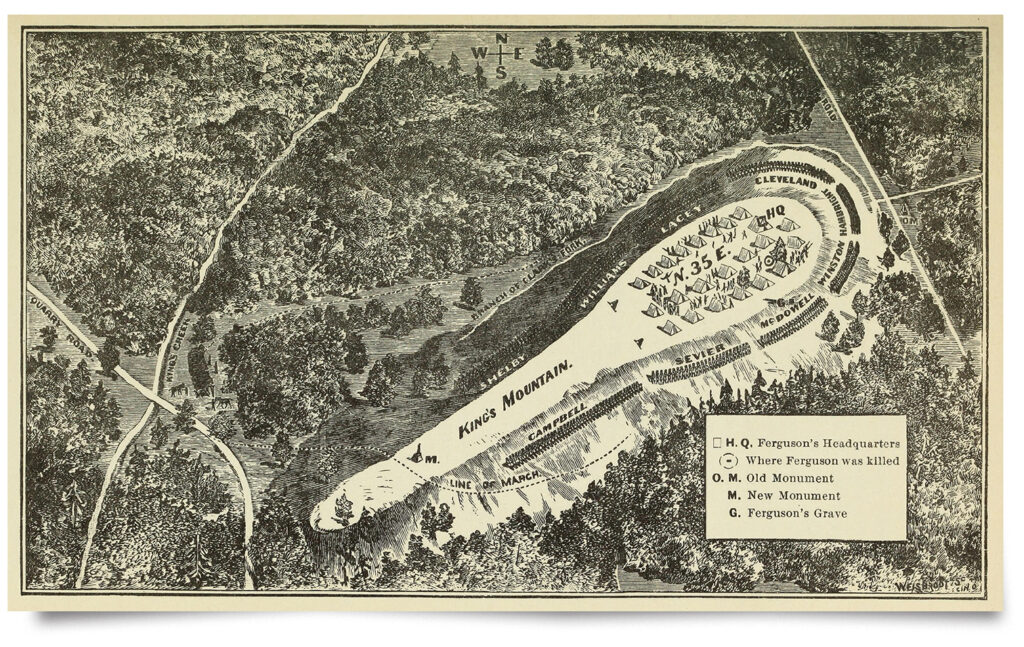
From Savannah the British army marched north to Charleston, S.C., which Clinton captured on May 12, 1780, after a six-week siege. He then returned to New York, tasking Cornwallis with subjugating the Carolinas. By summer Cornwallis had pushed north to Charlotte, N.C., and was concerned about protecting his flank. The threat he envisaged came from “Overmountain Men,” hardscrabble frontiersmen from west of the Blue Ridge Mountains, the leading edge of the Appalachian Range. Cornwallis assigned Ferguson’s battalion to counter the threat posed by the Patriot riflemen. The stage was set for the Battle of Kings Mountain.
Resolving that the best defense was a good offense, Ferguson departed Charlotte for the Appalachian reaches. According to American sources, en route Ferguson captured a Patriot and had the man relay a message to the “Backwater Men,” as the British called their foes west of the Blue Ridge. They were to lay down their arms in surrender, Ferguson warned, or the British would burn their farms and villages and hang their leaders. Whether those were truly Ferguson’s words or shrewd Patriot propaganda is unknown. As the message wasn’t written down, it cannot be proved or disproved. Regardless, at word of the threat the Overmountain Men mustered a superior force to repulse Ferguson’s militia. On September 30 Patriot deserters brought word of the onrushing American force. Ferguson gave the order to fall back on Cornwallis’ main army at Charlotte. He made it as far as Kings Mountain, straddling the border of North and South Carolina some 30 miles west of Charlotte.
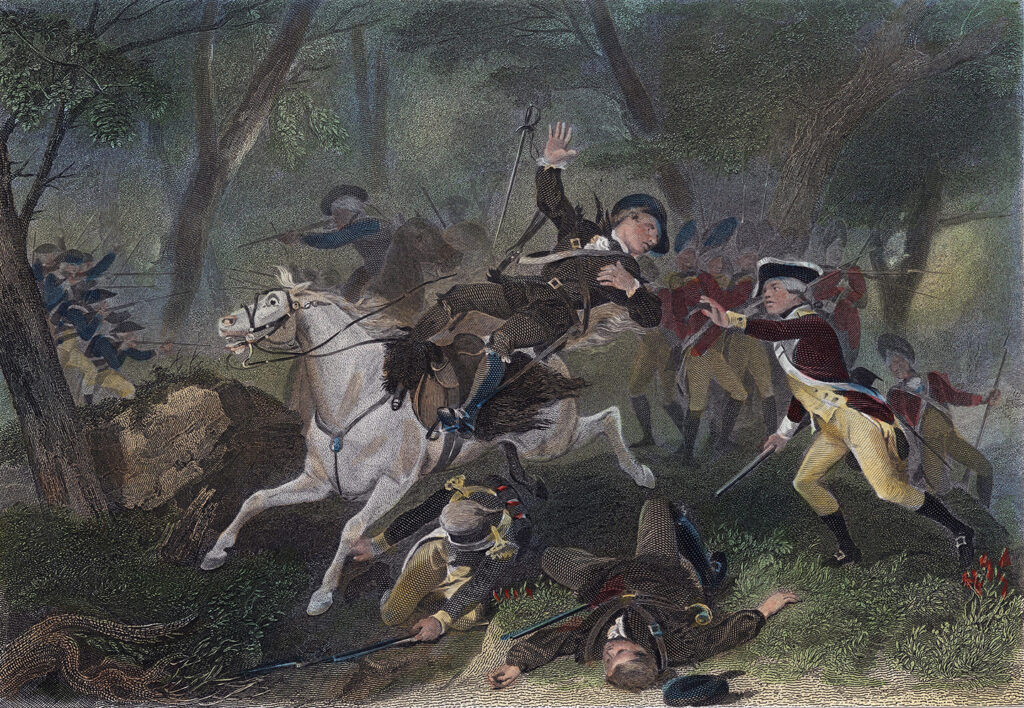
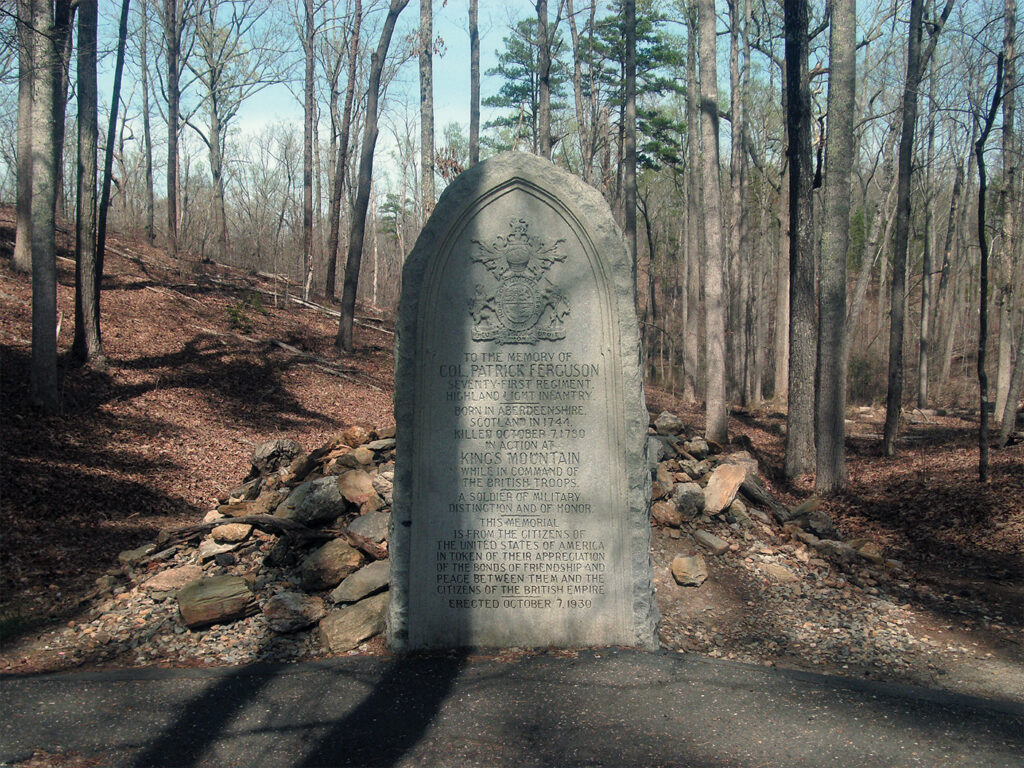
On Oct. 7, 1780, an advance party of 900 Overmountain Men on horseback surrounded Kings Mountain and attacked Ferguson’s command. Though caught by surprise and soon in desperate straits, the major rode back and forth among threatened points, repeatedly leading his men in bayonet attacks to repel the determined frontiersmen, who fought independently by detachment. Despite being severely wounded and having multiple horses shot from under him, Ferguson continued to fight and animate his men by example. Toward the end of the battle his second-in-command earnestly recommended the major surrender. Ferguson refused and in short order received a fatal rifle shot to the chest. Survivors later counted seven bullet wounds on his body. It was an abrupt end to a promising military career at age 36. In a battle that lasted just over an hour, 290 of Ferguson’s Loyalists were killed, 163 wounded and 668 captured, while the Patriots suffered 28 killed and 60 wounded. In its wake Cornwallis abandoned his ambitions in North Carolina and withdrew south.
Patrick Ferguson was buried on the spot along with a female companion named “Virginia Sal,” who was possibly his mistress. Their shared grave was marked by a stone cairn that still stands in present-day Kings Mountain National Military Park.
Retired U.S. Marine Colonel John Miles writes and delivers lectures on a range of historical topics. For further reading he recommends Every Insult and Indignity: The Life, Genius and Legacy of Major Patrick Ferguson, by Ricky Roberts and Bryan Brown; Biographical Sketch: Or, Memoir of Lieutenant Colonel Patrick Ferguson, by Adam Ferguson; The Philadelphia Campaign: Vol. 1: Brandywine and the Fall of Philadelphia, by Thomas J. McGuire; and Kings Mountain and Its Heroes, by Lyman C. Draper.
This story appeared in the 2023 Summer issue of Military History magazine.
historynet magazines
Our 9 best-selling history titles feature in-depth storytelling and iconic imagery to engage and inform on the people, the wars, and the events that shaped America and the world.


